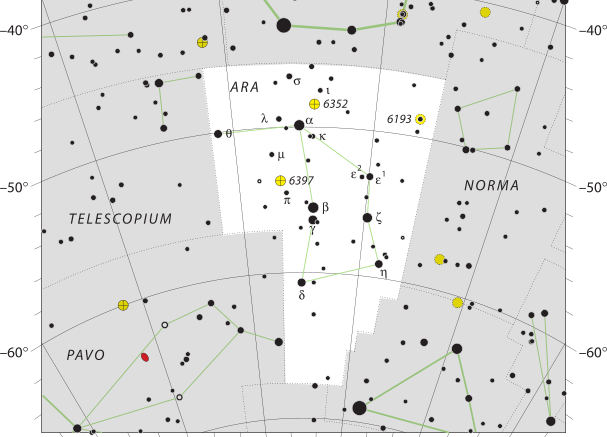Located in the Southern Hemisphere, the constellation Ara, lies between Scorpius, Telescopium, Triangulum Australe and Norma. Ara means ‘the altar’ in Latin and was 1 of the 48 constellations described by 2nd-century Greek astronomer Ptolemy. Ara remains one of the 88 modern constellations defined by the International Astronomical Union. Ara covers 237.1 square degrees in the sky, which makes it the 63rd largest constellation by area of the 88 modern constellations. The constellation covers .575% of the sky. Because of its position in the Southern Celestial Hemisphere, the whole constellation is visible to observers south of 22°N.
The orange supergiant Beta Arae is the brightest star in the constellation for observers on Earth and is marginally brighter than blue-white Alpha Arae. Seven star systems are known to host planets.
| Applicable Information | |
| Visibility In Pacific Northwest | Not visible from Pacific Northwest |
| Best Times To View | Not visible from Pacific Northwest |
| Right Ascension | −45.4859734°–−67.6905823° |
| Declination | −45.4859734°–−67.6905823° |
| Area | 237 square degrees |
| Main Stars | 8 |
| Brightest Object | β Ara |
| Meteor showers | 0 |
| Messier objects | 0 |
| Neighboring Constellations | Corona Australis, Scorpius, Norma, Triangulum Australe, Apus, Pavo, Telescopium |
History
In ancient Greek mythology, Ara was identified as the altar where the gods first made offerings and formed an alliance before defeating the Titans. In his depictions of the sky, Ara was one of the most southern constellations that Ptolemy was able to depict. A depiction had by Aratus in 270 BC had Aara lying close to the horizon, and the Almagest portrays stars as far south as Gamma Arae.
In illustrations, Ara is usually depicted as compact classical altar with its smoke ‘rising’ southward. However, depictions often vary.
In Chinese astronomy, the stars of the constellation Ara lie within The Azure Dragon of the East.[1] Five stars of Ara formed Guī, a tortoise, while another three formed Chǔ, a pestle.
The Wardaman people of the Northern Territory in Australia saw the stars of Ara and the neighbouring constellation Pavo as flying foxes.[2]
Stars
Ara contains part of the Milky Way to the south of the constellation Scorpius and thus contains rich star fields. Within the constellation’s borders, there are 71 stars brighter than or equal to apparent magnitude 6.5.
The northwest corner of Ara is crossed by the galactic plane of the Milky Way, and contains several open clusters and diffuse nebulae. The brightest of the globular clusters, sixth magnitude NGC 6397, lies at a distance of just 6,500 light-years from Earth, making it one of the closest globular clusters to the Solar System.
Two spiral galaxies, NGC 6215 and NGC 6221, are visible near star Eta Arae.
Open clusters
- NGC 6193, NGC 6200, NGC 6204, NGC 6208, NGC 6250, NGC 6253, and IC 4651
NGC 6193 is an open cluster containing approximately 30 stars with an overall magnitude of 5.0 and a size of 0.25 square degrees, which is about half the size of the full Moon. NGC 6193 is surrounded by NGC 6188, a faint nebula, which can be viewed by using long-exposure photographs.
Globular clusters
- NGC 6352, NGC 6362, and NGC 6397.
NGC 6397 is a globular cluster with an overall magnitude of 6.0 which is visible to the naked eye under exceptionally dark skies and is normally visible in binoculars.
Make sure to check out other articles on the site, including a brief introduction to constellations, other constellation articles, and more!
Sources
[1] = AEEA 2006.
[2] = Harney, Bill Yidumduma; Cairns, Hugh C. (2004) [2003]. Dark Sparklers (Revised ed.). Merimbula, New South Wales: Hugh C. Cairns. p. 201. ISBN 978-0-9750908-0-0.

Be the first to comment on "Ara"